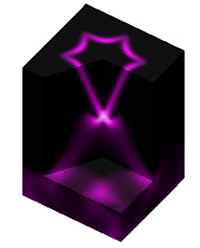- Number 290 |
- July 6, 2009
New exotic material could revolutionize electronics

Surface electron band structure of
bismuth telluride. (Image courtesy
of Yulin Chen and Z. X. Shen.)
Move over, silicon—it may be time to give the Valley a new name. Physicists at DOE's SLAC National Accelerator Laboratory and Stanford University have confirmed the existence of a type of material that could one day provide dramatically faster, more efficient computer chips.
Recently-predicted and much-sought, the material allows electrons on its surface to travel with no loss of energy at room temperatures and can be fabricated using existing semiconductor technologies. Such material could provide a leap in microchip speeds, and even become the bedrock of an entirely new kind of computing industry based on spintronics, the next evolution of electronics.
Physicists Yulin Chen, Zhi-Xun Shen and their colleagues tested the behavior of electrons in the compound bismuth telluride. The results, published online June 11 in Science Express, show a clear signature of what is called a topological insulator, a material that enables the free flow of electrons across its surface with no loss of energy.
The discovery was the result of teamwork between theoretical and experimental physicists at the Stanford Institute for Materials & Energy Science, a joint SLAC-Stanford institute. In recent months, SIMES theorist Shoucheng Zhang and colleagues predicted that several bismuth and antimony compounds would act as topological insulators at room-temperature.
The experimenters examined bismuth telluride samples using X-rays from the Stanford Synchrotron Radiation Lightsource at SLAC and the Advanced Light Source at Lawrence Berkeley National Laboratory. They found the clear signature of a topological insulator. Not only that, the group discovered that the reality of bismuth telluride was even better than theory: bismuth telluride can tolerate even higher temperatures than theorists had predicted.
"This means that the material is closer to application than we thought," Chen said.
Submitted by DOE's SLAC National Accelerator Laboratory
